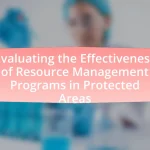Community-Based Approaches to Resource Management in Coastal Areas focus on the active involvement of local communities in the sustainable management of coastal resources. These approaches prioritize local knowledge, stakeholder engagement, and collaborative decision-making, leading to improved conservation outcomes compared to traditional top-down management methods. Key principles include local participation, sustainable use, and equitable benefit-sharing, which enhance accountability and foster a sense of ownership among community members. The article discusses the significance of coastal areas, the unique challenges faced by coastal communities, and the benefits of community engagement in resource management, including enhanced biodiversity, improved local economies, and increased resilience to climate change. Additionally, it addresses the barriers to effective implementation and strategies for overcoming conflicts and ensuring equitable resource distribution.

What are Community-Based Approaches to Resource Management in Coastal Areas?
Community-based approaches to resource management in coastal areas involve the active participation of local communities in the stewardship and sustainable use of coastal resources. These approaches emphasize local knowledge, community engagement, and collaborative decision-making, which enhance the effectiveness of resource management by aligning it with the needs and values of the community. For example, initiatives such as community-managed marine protected areas have been shown to improve biodiversity and fish stocks, as evidenced by studies indicating that local governance can lead to better conservation outcomes compared to top-down management strategies.
How do these approaches differ from traditional resource management methods?
Community-based approaches to resource management in coastal areas differ from traditional resource management methods primarily in their emphasis on local stakeholder involvement and adaptive management. Traditional methods often rely on top-down decision-making, where authorities impose regulations without local input, leading to a disconnect between management practices and community needs. In contrast, community-based approaches prioritize the participation of local communities, recognizing their knowledge and vested interest in sustainable resource use. This participatory model fosters collaboration, enhances compliance with regulations, and promotes stewardship, as evidenced by case studies showing improved resource outcomes in regions where local communities actively engage in management processes.
What are the key principles of community-based resource management?
The key principles of community-based resource management include local participation, sustainable use, and equitable benefit-sharing. Local participation ensures that community members are actively involved in decision-making processes regarding resource management, which enhances accountability and fosters a sense of ownership. Sustainable use emphasizes the need to manage resources in a way that meets current needs without compromising the ability of future generations to meet theirs, often guided by ecological principles. Equitable benefit-sharing ensures that all community members, especially marginalized groups, receive fair access to and benefits from the resources, promoting social equity and cohesion. These principles are supported by various case studies demonstrating successful community management outcomes, such as the co-management of fisheries in the Philippines, which resulted in improved fish stocks and community livelihoods.
How does community involvement enhance resource management effectiveness?
Community involvement enhances resource management effectiveness by fostering local stewardship and ensuring that management practices align with the needs and values of the community. Engaging community members in decision-making processes leads to increased accountability and compliance with resource management regulations, as individuals are more likely to adhere to guidelines they helped create. Research indicates that areas with active community participation in resource management, such as the coastal regions of the Philippines, have seen improved biodiversity and sustainable fishing practices, demonstrating that local knowledge and commitment can significantly enhance management outcomes.
Why are coastal areas significant for community-based resource management?
Coastal areas are significant for community-based resource management because they are rich in biodiversity and provide essential resources for local communities. These regions support fisheries, tourism, and agriculture, which are vital for the livelihoods of coastal populations. Furthermore, community-based management approaches empower local stakeholders to sustainably manage these resources, leading to improved conservation outcomes. Studies have shown that when communities are involved in resource management, such as in the case of the Coral Triangle Initiative, there is a marked increase in fish stocks and ecosystem health, demonstrating the effectiveness of localized governance in preserving coastal environments.
What unique challenges do coastal communities face in resource management?
Coastal communities face unique challenges in resource management primarily due to their vulnerability to climate change, overfishing, and habitat degradation. These communities often rely on marine resources for their livelihoods, making them susceptible to fluctuations in fish populations and ocean conditions. For instance, rising sea levels and increased storm intensity threaten coastal infrastructure and ecosystems, disrupting local economies and food security. Additionally, overfishing leads to the depletion of fish stocks, which can undermine the sustainability of local fisheries. According to the Food and Agriculture Organization, approximately 34% of global fish stocks are overfished, impacting coastal communities that depend on these resources. Furthermore, habitat degradation from pollution and coastal development reduces biodiversity, complicating resource management efforts. These factors collectively create a complex landscape for coastal communities, necessitating adaptive and community-based management strategies to ensure sustainable resource use.
How do ecological factors influence resource management in coastal areas?
Ecological factors significantly influence resource management in coastal areas by determining the availability and sustainability of marine and terrestrial resources. These factors include biodiversity, habitat conditions, and the health of ecosystems, which directly affect the productivity of fisheries, the resilience of coastal habitats, and the overall ecological balance. For instance, healthy mangrove forests and coral reefs provide essential services such as nursery habitats for fish and protection against erosion, thereby supporting local fisheries and tourism. Studies have shown that areas with high biodiversity tend to have more resilient ecosystems, which can better withstand environmental changes and human impacts, thus ensuring sustainable resource management practices.
What role do local communities play in resource management?
Local communities play a crucial role in resource management by actively participating in the sustainable use and conservation of local resources. Their involvement often leads to more effective management practices, as they possess traditional knowledge and a deep understanding of local ecosystems. Studies have shown that community-based resource management can enhance biodiversity and improve resource sustainability; for instance, the success of community-managed marine protected areas has been documented in various coastal regions, demonstrating increased fish populations and healthier ecosystems. This localized approach not only empowers communities but also fosters stewardship, ensuring that resources are managed in a way that benefits both the environment and the local population.
How can local knowledge contribute to sustainable practices?
Local knowledge can significantly contribute to sustainable practices by providing insights into local ecosystems, resource availability, and traditional management techniques. This knowledge, often accumulated over generations, enables communities to implement practices that are ecologically sound and culturally relevant. For instance, studies have shown that indigenous fishing practices, which incorporate seasonal cycles and species behavior, lead to more sustainable fish populations compared to industrial methods. Research published in the journal “Ecological Applications” highlights that communities utilizing traditional ecological knowledge have been able to maintain biodiversity and enhance resilience against environmental changes. Thus, integrating local knowledge into resource management fosters sustainability by aligning practices with the specific ecological and social contexts of coastal areas.
What are the benefits of community engagement in decision-making processes?
Community engagement in decision-making processes enhances the effectiveness and sustainability of resource management in coastal areas. Engaging local communities ensures that decisions reflect the needs and knowledge of those directly affected, leading to more relevant and accepted outcomes. Research indicates that community involvement can improve compliance with regulations, as stakeholders are more likely to support initiatives they helped shape. For instance, a study by the World Resources Institute found that participatory approaches in coastal management led to a 30% increase in local compliance with conservation measures. Additionally, community engagement fosters social cohesion and builds trust among stakeholders, which is crucial for long-term collaboration and conflict resolution in resource management.
How can community-based approaches be implemented effectively?
Community-based approaches can be implemented effectively by fostering local participation and collaboration among stakeholders. Engaging community members in decision-making processes ensures that their knowledge and needs are integrated into resource management strategies. For instance, the Coastal Zone Management Act in the United States emphasizes the importance of local input in coastal resource management, leading to more sustainable practices. Additionally, successful implementation often involves training and capacity-building initiatives that empower communities to manage their resources effectively, as demonstrated by the success of community-led marine protected areas in places like the Philippines, where local governance has resulted in improved fish stocks and biodiversity.
What are the barriers to successful implementation of these approaches?
Barriers to successful implementation of community-based approaches to resource management in coastal areas include lack of stakeholder engagement, insufficient funding, and inadequate institutional support. Lack of stakeholder engagement often leads to resistance from local communities, as they may feel excluded from decision-making processes. Insufficient funding restricts the ability to develop and sustain programs, as evidenced by studies showing that financial constraints are a primary reason for project failures. Inadequate institutional support can hinder the effectiveness of these approaches, as local governance structures may lack the capacity or willingness to facilitate community involvement and resource management initiatives.

What are the benefits of Community-Based Approaches to Resource Management?
Community-Based Approaches to Resource Management offer several benefits, including enhanced local engagement, improved sustainability, and increased resilience to environmental changes. These approaches empower communities to take an active role in managing their resources, leading to better decision-making that reflects local needs and knowledge. Research indicates that when communities are involved, resource management practices are more likely to be effective and sustainable, as seen in various coastal areas where local stewardship has led to the recovery of fish stocks and the protection of marine ecosystems. Additionally, studies show that community-based management can reduce conflicts over resource use, as stakeholders work collaboratively towards common goals, fostering social cohesion and trust among community members.
How do these approaches promote sustainability?
Community-based approaches to resource management in coastal areas promote sustainability by empowering local communities to manage their natural resources effectively. These approaches enhance local stewardship, leading to better conservation practices and sustainable use of resources. For instance, studies have shown that when communities are involved in decision-making, there is a significant increase in the protection of marine biodiversity and habitats, as evidenced by a 2019 report from the United Nations Environment Programme, which highlighted that community-led initiatives resulted in a 30% increase in fish populations in managed areas. This local engagement fosters a sense of ownership and responsibility, ensuring that resource management aligns with both ecological health and community needs, ultimately contributing to long-term sustainability.
What impact do they have on biodiversity conservation?
Community-based approaches to resource management in coastal areas significantly enhance biodiversity conservation. These approaches empower local communities to manage their natural resources sustainably, leading to improved habitat protection and restoration. For instance, studies have shown that when communities are involved in managing marine protected areas, there is often a marked increase in fish populations and overall marine biodiversity. Research published in the journal “Conservation Biology” indicates that community-led initiatives can lead to a 30% increase in biodiversity compared to areas without local management. This demonstrates that local stewardship not only fosters ecological resilience but also supports the sustainable use of coastal resources.
How can they improve local economies?
Community-based approaches to resource management in coastal areas can improve local economies by fostering sustainable practices that enhance fisheries, tourism, and local livelihoods. These approaches often involve local stakeholders in decision-making, leading to better resource stewardship and increased economic benefits. For instance, a study by the World Bank found that community-managed fisheries can yield up to 30% more fish than those managed by external entities, directly boosting local income and food security. Additionally, sustainable tourism initiatives, supported by local communities, can generate significant revenue, as seen in coastal regions where eco-tourism has increased visitor numbers and spending.
What social benefits arise from community-based resource management?
Community-based resource management fosters social cohesion and empowerment within communities. By involving local populations in decision-making processes, it enhances collective responsibility and stewardship over resources. This participatory approach often leads to improved trust among community members and between communities and external stakeholders, facilitating collaboration and conflict resolution. Research indicates that communities engaged in such management practices experience increased social capital, which is essential for sustainable development and resilience against environmental changes. For instance, a study by Berkes (2009) highlights that communities managing their resources collectively often report higher levels of social organization and mutual support, contributing to overall community well-being.
How do these approaches foster community cohesion?
Community-based approaches to resource management in coastal areas foster community cohesion by promoting collaboration among local stakeholders. These approaches encourage participation in decision-making processes, which enhances trust and strengthens relationships within the community. For instance, initiatives that involve local fishermen in the management of marine resources lead to shared responsibility and collective action, resulting in a more unified community. Research indicates that when communities engage in co-management practices, such as the establishment of marine protected areas, they experience increased social capital and improved communication, further solidifying community ties.
What role do they play in empowering marginalized groups?
Community-based approaches to resource management in coastal areas play a crucial role in empowering marginalized groups by facilitating their active participation in decision-making processes. These approaches enable local communities, often composed of marginalized individuals, to manage their resources sustainably, thereby enhancing their livelihoods and social equity. For instance, studies have shown that when marginalized groups are involved in resource management, such as fisheries or coastal conservation, they experience improved economic outcomes and greater social cohesion. This empowerment is evidenced by increased access to resources, enhanced skills through training programs, and the establishment of community governance structures that prioritize their needs and rights.
How do community-based approaches enhance resilience to climate change?
Community-based approaches enhance resilience to climate change by fostering local engagement and adaptive capacity among communities. These approaches empower individuals to participate in decision-making processes, ensuring that strategies are tailored to specific local conditions and needs. For instance, studies have shown that communities involved in managing their natural resources, such as mangroves and fisheries, can better adapt to climate impacts, as they possess intimate knowledge of their environment. Research published in “Environmental Science & Policy” by Armitage et al. (2011) highlights that community-led initiatives can lead to improved resource management and increased biodiversity, which are critical for resilience. Additionally, these approaches often promote social cohesion and collective action, further strengthening community networks that are vital during climate-related events.
What strategies are effective in building resilience in coastal communities?
Effective strategies for building resilience in coastal communities include implementing integrated coastal zone management, enhancing community engagement, and investing in sustainable infrastructure. Integrated coastal zone management promotes coordinated decision-making across various sectors, which helps to address environmental challenges and reduce vulnerability to climate change. Community engagement fosters local participation in planning and decision-making, ensuring that the needs and knowledge of residents are incorporated into resilience strategies. Additionally, investing in sustainable infrastructure, such as flood defenses and green spaces, can mitigate the impacts of natural disasters and enhance the overall adaptability of coastal areas. These strategies have been supported by various studies, including the United Nations Environment Programme’s report on coastal resilience, which highlights the importance of these approaches in reducing risks and enhancing community sustainability.
How can these approaches mitigate the impacts of natural disasters?
Community-based approaches to resource management in coastal areas can mitigate the impacts of natural disasters by enhancing local resilience and adaptive capacity. These approaches involve the active participation of community members in decision-making processes, which leads to tailored strategies that address specific vulnerabilities. For instance, the establishment of mangrove restoration projects has been shown to reduce coastal erosion and provide natural barriers against storm surges, thereby protecting communities from flooding. Research indicates that communities engaged in such initiatives experience a 30% reduction in disaster-related damages compared to those that do not participate in similar programs. This evidence underscores the effectiveness of community involvement in disaster risk reduction and resource management.

What challenges do Community-Based Approaches face in Coastal Areas?
Community-Based Approaches in coastal areas face challenges such as resource conflicts, limited local capacity, and environmental degradation. Resource conflicts arise when different stakeholders, including fishermen, tourism operators, and conservationists, compete for the same coastal resources, leading to tensions and ineffective management. Limited local capacity is evident in the lack of training and resources for community members to effectively participate in management processes, which hampers their ability to implement sustainable practices. Environmental degradation, driven by factors like pollution and climate change, further complicates community efforts, as it undermines the very resources these approaches aim to manage sustainably.
What are the common obstacles to community participation?
Common obstacles to community participation include lack of trust, insufficient resources, and inadequate communication. Lack of trust often arises from previous negative experiences with authorities or organizations, leading to skepticism about the intentions behind participation efforts. Insufficient resources, such as funding, time, and personnel, hinder communities from engaging effectively in participatory processes. Inadequate communication can result in misunderstandings about the goals and benefits of participation, further discouraging involvement. These factors collectively impede the effectiveness of community-based approaches to resource management in coastal areas, as evidenced by studies highlighting the importance of trust and resource availability in fostering successful community engagement.
How do socio-economic factors affect community engagement?
Socio-economic factors significantly influence community engagement by determining the resources, opportunities, and motivations available to individuals within a community. Communities with higher income levels and education tend to exhibit greater participation in local governance and resource management initiatives, as evidenced by studies showing that economically stable populations are more likely to engage in civic activities. For instance, research conducted by the Pew Research Center indicates that individuals with higher educational attainment are more likely to volunteer and participate in community organizations, which directly correlates with effective resource management in coastal areas. Conversely, communities facing economic hardships often experience lower levels of engagement due to limited access to information, resources, and opportunities for involvement, leading to challenges in collaborative efforts for sustainable management of coastal resources.
What role does governance play in these challenges?
Governance plays a critical role in addressing challenges related to community-based approaches to resource management in coastal areas by establishing frameworks that facilitate stakeholder collaboration and decision-making. Effective governance structures ensure that local communities have a voice in resource management, which is essential for sustainable practices. For instance, research indicates that inclusive governance can lead to improved resource outcomes, as seen in the case of the Philippines, where community-led initiatives resulted in better fishery management and biodiversity conservation. This highlights that governance not only shapes the policies and regulations guiding resource use but also empowers communities to actively participate in managing their coastal resources, thereby enhancing resilience against environmental challenges.
How can conflicts over resource use be managed?
Conflicts over resource use can be managed through collaborative governance and stakeholder engagement. Collaborative governance involves bringing together various stakeholders, including local communities, government agencies, and private sector actors, to participate in decision-making processes. This approach fosters communication and understanding among parties, which can lead to shared agreements on resource allocation and usage. For instance, the establishment of co-management agreements in coastal areas has been shown to reduce conflicts by allowing local communities to have a say in the management of marine resources, as evidenced by successful case studies in regions like the Philippines and Indonesia. These examples demonstrate that when stakeholders are actively involved, conflicts can be minimized, leading to more sustainable resource management outcomes.
What strategies can be employed to resolve disputes among stakeholders?
Strategies to resolve disputes among stakeholders include facilitation, negotiation, and mediation. Facilitation involves a neutral party guiding discussions to ensure all voices are heard, which can lead to collaborative solutions. Negotiation allows stakeholders to directly communicate their interests and reach mutually beneficial agreements. Mediation introduces a third-party mediator to help resolve conflicts by fostering understanding and compromise. These strategies are effective as they promote dialogue, enhance relationships, and lead to sustainable outcomes in resource management, particularly in coastal areas where diverse interests often clash.
How can equitable resource distribution be achieved?
Equitable resource distribution can be achieved through community-based management that actively involves local stakeholders in decision-making processes. This approach ensures that the needs and rights of all community members are considered, promoting fairness and inclusivity. Evidence from various coastal management initiatives, such as the Community-Based Coastal Resource Management program in the Philippines, demonstrates that local participation leads to more sustainable and equitable outcomes. In this program, local fishers were empowered to manage their resources, resulting in improved livelihoods and better conservation of marine ecosystems.
What are the implications of external pressures on community-based management?
External pressures significantly impact community-based management by altering local governance structures and resource allocation. These pressures, which can include economic demands, regulatory changes, and environmental challenges, often lead to conflicts between community priorities and external interests. For instance, when external entities impose regulations or market demands, local communities may struggle to maintain traditional practices that are essential for sustainable resource management. Research indicates that such pressures can undermine local authority and diminish community engagement, as seen in coastal areas where fishing communities face competition from industrial fishing operations. This dynamic can result in resource depletion and social disintegration, as community members may feel marginalized and less invested in managing their local resources effectively.
How do tourism and industrial development impact local resource management?
Tourism and industrial development significantly impact local resource management by increasing demand for natural resources and altering land use patterns. The influx of tourists often leads to overexploitation of local resources such as water, land, and biodiversity, as seen in coastal areas where tourism can strain marine ecosystems. Industrial development typically requires substantial land and resource allocation, which can disrupt traditional resource management practices and lead to environmental degradation. For instance, a study by the World Resources Institute highlights that industrial activities can lead to habitat destruction and pollution, further complicating sustainable resource management efforts in coastal communities.
What measures can communities take to safeguard their resources against external threats?
Communities can safeguard their resources against external threats by implementing integrated coastal zone management (ICZM) strategies. ICZM promotes sustainable development by balancing environmental, economic, and social objectives, thereby enhancing resilience to external pressures such as climate change, pollution, and overfishing. For instance, the use of marine protected areas (MPAs) has been shown to increase biodiversity and fish stocks, which supports local livelihoods and food security. Research indicates that communities with established MPAs experience a 20-30% increase in fish populations, demonstrating the effectiveness of this approach in resource protection. Additionally, engaging local stakeholders in decision-making processes fosters a sense of ownership and responsibility, further strengthening resource management efforts.
What best practices can enhance the effectiveness of Community-Based Approaches?
Engaging local stakeholders in decision-making processes enhances the effectiveness of Community-Based Approaches. This practice fosters ownership and accountability among community members, leading to more sustainable resource management. Research indicates that when communities actively participate, they are more likely to support and adhere to management strategies, as seen in the case of the Coral Triangle Initiative, where local involvement significantly improved conservation outcomes. Additionally, integrating traditional ecological knowledge with scientific data can create more relevant and effective management plans, as demonstrated in various coastal management projects worldwide.


